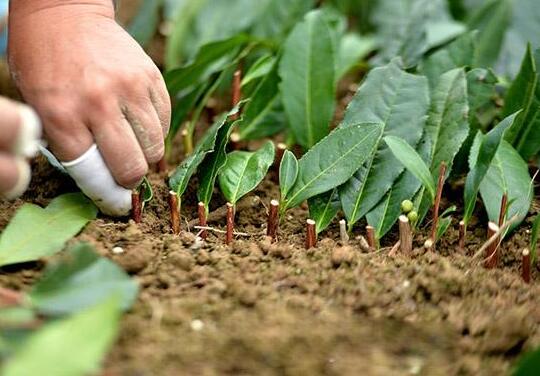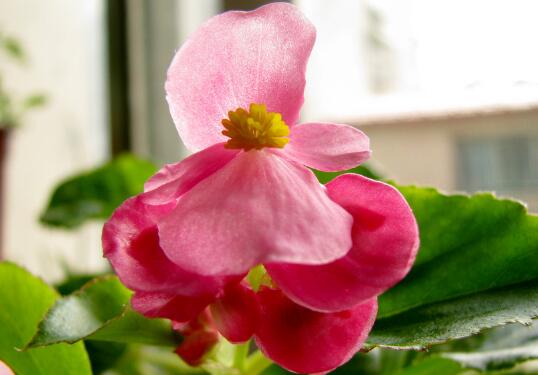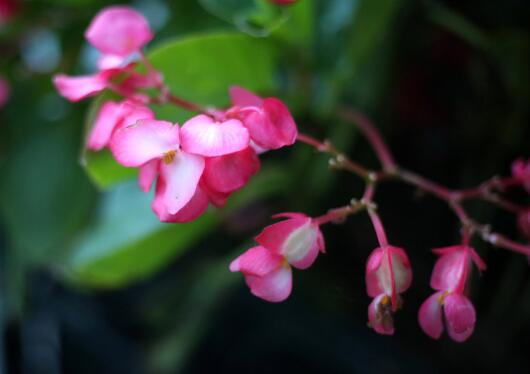How to cut begonia in four seasons, the best cutting method is graphic / April-May cutting.
In the propagation methods of four seasons begonia, cutting propagation is a more commonly used method, and the survival rate is also relatively high, but the premise is that you have to master the correct operation method, so how to cut begonia? What is the diagram of the cutting method of Begonia in four seasons? Next, the editor will take you to learn about it.
First, how to cut begonia in four seasons

Second, the diagram of the cutting method of four seasons crabapple.
1. Cutting time
When we are ready for cutting propagation of four seasons crabapple, it is best to choose a suitable period of time, which can greatly improve the rooting rate. Generally, cutting from April to May is the best, because the air humidity in this period is relatively high, and the climate is also more suitable, which can make the four seasons crabapple take root quickly.
two。 Matrix selection
In the cutting of four seasons crabapple, the selection of substrate is a very important part, generally, it is best to choose sandy soil with high porosity, which has good air permeability and drainage, which can better absorb nutrients and improve the success rate of cutting.
3. Cuttings selection
In the four seasons begonia cutting method, the selection of cuttings is also a more important step, in general, it is best to choose more robust branches, so that the survival rate will be higher, if you choose branches that look very slender, then it is basically difficult to survive. After selecting the cuttings, we need to cut the upper part into a flat top shape and the lower part into a horseshoe shape, which can expand the contact surface with the soil and promote rooting.
4. Cutting method
About the four seasons crabapple how to cut, in fact, the method is very simple, first of all, we can use chopsticks to cut a hole in the soil, so that after the cuttings into the soil 2/3 can be watered, watering attention to a thorough watering, must not cause stagnant water, otherwise it is easy to cause root rot, after 10 days or so can take root.
5. Subsequent management
After the four Seasons Begonia has successfully taken root in the cuttings, we can carry out follow-up conservation, and there are also many points that need to be paid attention to in the process of conserving the four Seasons Begonia. For details, you can take a look at the article on the correct culture methods of Begonia. There is detailed conservation teaching, and the editor will not repeat it here.
[how to cut four Seasons Begonia] Diagram of cutting method of four Seasons Begonia
The cutting propagation of four Seasons Begonia has undoubtedly become the way for most flower friends to reproduce begonia, but in the process of reproduction, how to cuttage flower friends has made it difficult, so how to cuttage Begonia? Next, let's talk about the cutting method of four seasons crabapple.
Cutting method of four Seasons Begonia cutting time of four Seasons Malus
The time of cutting propagation of four seasons begonia in the family should be carried out between April and May every year, when the temperature rises back to 20 ℃ when the spring blossoms, the air humidity is higher, the ambient temperature increases, and the management of four seasons crabapple is simple, which is more suitable for the rapid rooting and sprouting of four seasons crabapple.
Cutting substrate of four Seasons Malus
The river sand needs to be washed, dried, and placed in a basin. At this moment, the dried river sand has reached the intention of disinfection, and putting the dried river sand in the basin is beneficial to promote the healing of cutting branches and the heating up of the white sunshine of the basin soil.
Selection of four Seasons Begonia cuttings
When selecting cuttings, four seasons begonia should choose strong 1-2-year-old branches for cutting, each branch with 3-4 nodes, cut into a flat column, cut into a horseshoe. In this way, the touch area between cuttings and sand can be expanded and the rooting of plants can be promoted.
Cutting and management of crabapple in four seasons
Cut the plant into the pot with a row spacing of 3 cm to 4 cm, not too close. Before cutting, prepare a bamboo stick with the same thickness as the cuttings to insert the basin sand out of the hole, and then pierce the branches of the four seasons begonia from the hole, and there is no need to sprinkle water at the disposal of 2 days after cutting, so as to facilitate the healing of the cutting surface and avoid decay.
Sprinkle water to the basin on the 5th day after insertion. Put the implicated pot in a cool place and no longer sprinkle water. 3-4cm roots can grow after 10 days, when the pot is placed in the sun, sprinkled according to the climate, and can be planted in the basin after 6-7 days.
Diagram of the method of beheading cuttage of Malus angustifolia
Staghorn crabapple is a particularly lovely succulent, its leaves are thick and lovely, the color is green, fresh and beautiful, with high ornamental value. The planting method of Begonia is also relatively simple, and the growth rate is fast, especially in the case of lack of sunlight, it is easy to grow in vain, so do you know how to cut off the head cuttings of Begonia?
How does Begonia reproduce
1. Suitable cutting substrate.
The propagation of Malus angustifolia is mainly based on cutting. the substrate of cutting needs to have good performance, not only good drainage function and air permeability, but also good function of keeping water and air. For example, perlite, peat ash, vermiculite, cinder and so on can be used together. But disinfection must be carried out before use. At the same time, the lower part of the matrix needs to lay an appropriate amount of plant materials rich in corrosive nutrients, and it is best to use larger particles at the bottom of the matrix to lay the drainage layer.
2. Keep the air humid
Be sure to avoid a sudden drop in air relative humidity after cutting, and it is best to keep it above 70%, especially before taking root. It is recommended to keep the air relative humidity at 90%.
3. Proper lighting
After cutting, the light should not be too much or too little, otherwise it will affect the growth of adventitious roots and the insufficient supply of nutrients. It is best to put it in a cool place with astigmatism. Never shine directly into the sun, nor can it be completely dark.
4. Suitable temperature
The most suitable temperature for cutting is between 20 and 35 degrees, during which the harm caused by rotting bacteria can be reduced. And the temperature change in the morning and evening is easier to take root than when the temperature is constant.
5. Maintenance and management
To sum up the details of the protection of Begonia after cutting, it is necessary to choose a suitable temperature and substrate to maintain a high relative humidity of the air and avoid direct sunlight. Once hyphae are found in the matrix, fungicides should be used to spray them in time. Everyone should remember, do not move and touch because of impatience.
Graphic method of beheading cuttage of Malus angustifolia
1. First of all, remove all the staghorn begonia from the basin and trim the root system.
2. After mending the back root, take a look, the antler crabapple has grown to 10 centimeters, beheading is necessary.
3, cut off the head, usually 2-3 stem nodes will be fine.
4. This is the deer horn begonia that has gone too far.
5. Then the deer horn begonia was planted respectively.
6. After a year of good maintenance, there is another strong pot of deer horn begonia.
Taboo on maintenance of Begonia angustifolia
1. Watering taboos
Be sure to water less in winter, and slowly stop watering when the temperature drops below 2 degrees. As long as you keep the basin soil dry, you can pass the winter safely. Do not go desperately to fertilize in order to make it grow better, or it will have the opposite effect.
2. Taboos of fertilization
Generally speaking, when it is growing relatively vigorously, we can give it some nourishment and water, but when the temperature is too low, we must stop fertilizing.
3. Pay attention to diseases and insect pests
If it is not well maintained in winter, it is likely to make its roots easy to give birth to worms. At this time, we must pay attention to get rid of these pests in time, otherwise it will directly affect its growth and even die. So at this time, we can use drugs for certain prevention and treatment, so that it can pass the winter safely.
The value function of Malus angustifolia
1. Ornamental function
Antler Begonia potted plant is suitable for indoor viewing in winter, can also be used for hanging pot cultivation, more full of vitality, showing a festive atmosphere. It is also often used to arrange special gardens for succulent plants.
The plant of Malus angustifolia is not high, and most of the branches are creeping. Leaf blade fleshy trigonous, very special. It blossoms in winter in white, red and lavender colors. Potted plants are suitable for indoor viewing in winter and can also be used as hanging pots for cultivation, showing more vitality and festive atmosphere.
2. Purification effect
Staghorn crabapple is a kind of warm and dry soil, which requires growing in a sunny environment, especially afraid of cold. But very resistant to drought, too high temperature is not good, it is best to grow in sandy soil, many people plant antler Begonia in small flowerpots, which has become a good ornamental plant. Of course, put the antler crabapple next to the TV or computer, so that you can reduce radiation, put indoors can also absorb formaldehyde and other harmful substances, for indoor air purification, staghorn begonia has a high ornamental value.
As mentioned above, the appearance of antler begonia is very delicate and beautiful, but if it still grows without treatment, it will grow out of a state without aesthetic feeling. So let the antler begonia bask in the sun as much as possible, and try not to let it grow in vain.
- Prev

How to propagate the four Seasons Begonia, the Propagation method / sowing / cutting of the four Seasons Begonia
Four Seasons Begonia is a kind of highly ornamental flower, and there are many people who breed it in our country. With more and more breeders, people are more concerned about its reproduction, so how to breed it? What are the breeding methods of Begonia in four seasons? Next, the editor will take you to learn about it.
- Next

How to sow and propagate crabapple in four seasons, sowing in spring and autumn is the best / container disinfection / seed quickening.
Among the propagation methods of four seasons crabapple, sowing and reproduction is a more commonly used method. This method has been tested countless times, so the survival rate is still relatively high. Of course, the premise is that you have to master the correct sowing method. So how to sow and reproduce four seasons begonia? Next, the editor will take you to learn about it.
Related
- Fuxing push coffee new agricultural production and marketing class: lack of small-scale processing plants
- Jujube rice field leisure farm deep ploughing Yilan for five years to create a space for organic food and play
- Nongyu Farm-A trial of organic papaya for brave women with advanced technology
- Four points for attention in the prevention and control of diseases and insect pests of edible fungi
- How to add nutrient solution to Edible Fungi
- Is there any good way to control edible fungus mites?
- Open Inoculation Technology of Edible Fungi
- Is there any clever way to use fertilizer for edible fungus in winter?
- What agents are used to kill the pathogens of edible fungi in the mushroom shed?
- Rapid drying of Edible Fungi

